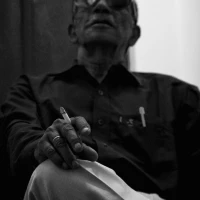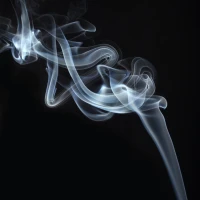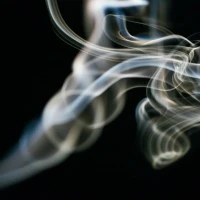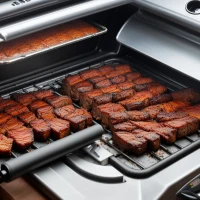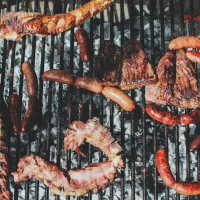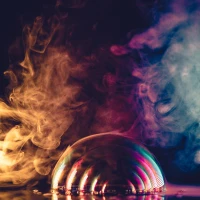When it comes to achieving the holy grail of barbecues—a perfectly smoked brisket—the debate between smoking at 250 degrees versus 225 degrees Fahrenheit is as intense as the heat within the smoker itself. With passionate pitmasters on both sides defending their preferred temperatures, the quest for ultimate flavor opens a savory world of low and slow cooking. But before firing up your smoker, it’s essential to understand the nuances that can transform your brisket from good to great. In this guide, we’ll explore the intricacies of smoking brisket at 250 vs 225 degrees, and how these temperatures can affect the tenderness, flavor, and overall success of your prized cut of meat.
The Art of Smoking Brisket: Understanding the Craft
Before diving into the heart of the temperature debate, let’s take a quick journey through the basics of smoking brisket, highlighting the importance smoking brisket at 250 degrees has gained among pitmasters, and why others swear by smoking brisket at 225 degrees instead.
Smoked Brisket Essentials: Meat and Heat
A brisket is a cut of beef that comes from the lower chest or breast of the cow. It’s known for its tough connective tissue, which requires a significant amount of time and careful temperature management to break down into succulent, tender goodness. The act of slow-smoking transforms this challenging piece of meat through a combination of:
- Low, indirect heat
- Smoke that imbues the meat with distinctive woody flavors
- Time allowing for the connective tissues to tenderize
The Impact of Temperature on Brisket Smoking
When smoking brisket, maintaining a steady temperature is critical. The choice of 250 vs 225 degrees is not merely about duration; it’s about the meat’s reaction to heat and smoke over time. At 250 degrees, brisket cooks a bit faster, and you obtain a potentially more robust bark, while at 225 degrees, the consensus is a longer cook that may yield even more tender meat.
Temperature Showdown: 250-Fahrenheit Versus 225-Fahrenheit for Smoking Brisket
Now that we’ve set the stage, let’s delve into the core of this culinary skirmish and examine how each temperature affects every facet of the brisket-smoking process. We’ll look at the science, the art, and the subtle touches that differentiate a good brisket from an unforgettable one.
Cooking Time: The Slow Dance of Heat and Meat
Let’s break down the time aspect when choosing to smoke a brisket. Smoking at 225 degrees generally adds to the cooking time.
- 250 degrees: Expect your brisket cook time to be about 1 hour per pound.
- 225 degrees: Anticipate approximately 1.5 hours per pound.
Bullet Point Takeaway:
- Faster cook times at 250 degrees; potentially shorter window of moisture retention.
- Longer cook times at 225 degrees; more time for fat and connective tissue breakdown.
Bark Development: The Quest for the Perfect Crust
The bark is the dark, flavorful crust that forms on the exterior of the brisket through the Maillard reaction and the caramelization of sugars.
- 250 degrees: Promotes quicker bark formation; risk of drying out if not careful.
- 225 degrees: Lower risk of drying, but patience is needed for bark development.
Moisture Retention: Juiciness Level-Up
Maintaining moisture is essential for a succulent brisket. Manage your smoker’s humidity and consider the airflow when cooking.
- 250 degrees: Moisture can evaporate more swiftly; consider a water pan.
- 225 degrees: Slower evaporation rate; potentially juicier outcome.
Flavor Deep Dive: Smoke Absorption
Smoke gives brisket its signature flavor. Wood choice matters here as much as temperature.
- 250 degrees: Brisket absorbs smoke quickly but spends less time in the smoker.
- 225 degrees: Longer exposure to smoke, possibly leading to a deeper flavor profile.
Tenderness and Texture: The Ultimate Goal
Brisket should be tender but not mushy. The “pull how to cut a cantaloupe in cubespart” quality is a dance between temperature, time, and meat internal structure.
- 250 degrees: Risk of less evenly distributed collagen breakdown.
- 225 degrees: Even, slow rendering of fats and collagen for optimal tenderness.
Ideally, you want your brisket to reach an internal temperature of about 195-205 degrees Fahrenheit, regardless of the smoker’s set temp, for perfect tenderness.
The Technical Tastes: Smoking Brisket at 250 Degrees
Now, let’s focus on the finer points of smoking your brisket at 250 degrees Fahrenheit. This temperature setting is considered a bit more modern and aggressive by some pitmasters; it provides a slightly different cooking experience and outcome for your brisket.
What Sets 250 Degrees Apart in the Smoking Process
When you opt for a 250-degree smoke, you’re choosing a quicker cook that potentially translates to a more rigid timetable spanning preparation, smoking, and resting.
The Brisket Barrier: Avoiding Overcooking at 250
It’s essential not to overcook your brisket at this higher temperature. Ensuring sufficient moisture through spritzing and the inclusion of a water pan can mitigate risks associated with the 250-degree approach.
Maximizing the 250-Degree Smoke
Here are some tips to get the most out of smoking at 250 degrees:
- Keep a consistent temperature: Fluctuations can affect cook time and tenderness badly.
- Monitor the brisket closely: Use probes to check internal temperature regularly.
- Rest the brisket: After smoking, let it rest wrapped in a cooler for at least an hour.
The Patience Play: Smoking Brisket at 225 Degrees
225 degrees Fahrenheit is often hailed as the traditional “low and slow” method. It’s a practice that’s tested by time, and it emphasizes patience above all else.
Why 225 Degrees Can Be Magical for Smoked Brisket
The magic of 225 degrees lies in its gentle, gradual cooking approach. This method is outstanding for those who love a process-oriented approach to barbecue, where watching and waiting is as integral to the experience as the eating.
Avoiding the Pitfalls: Keeping Brisket Moist at 225
To keep your brisket moist throughout the slower cooking process, consider these tactics:
- Use a water pan: This helps maintain humidity in the smoker.
- Spritz or baste the brisket: A mid-cook moisture infusion can do wonders.
- Maintain a tight seal on your smoker: Preventing smoke and heat escape keeps moisture and flavor locked in.
Tips for Smoking Success at 225 Degrees
Here are critical tips to succeed with the 225-degree method:
- Set aside ample time: Never rush a 225-degree brisket smoke; the beauty is in the time taken.
- Low and slow: Keep an eye on your smoker’s temperature, avoiding any sudden spikes.
- Resting is crucial: Similarly, resting post-smoke allows juices to redistribute, ensuring a tender final product.
The Decision: 250 or 225, Which is the Brisket Boss?
Ultimately, the decision of whether to smoke your brisket at 250 or 225 degrees boils down to personal preference, your schedule, and the desired outcome. Both temperatures can yield an exquisite brisket if managed properly.
Factors Influencing Your Temperature Choice
Consider these factors when choosing your smoking temperature:
- Time available: 250 degrees for a shorter cook or 225 degrees if you can afford to wait.
- Desired texture: Go for 225 degrees for a potentially more tender texture.
- Bark preferences: If you prioritize a robust bark, 250 degrees might be your sweet spot.
Pros and Cons: Quick Comparison
Let’s lay it out straight—pros and cons for smoking brisket at 250 vs 225 degrees.
250 Degrees:
Pros:
- Quicker cooking time may suit busy schedules better.
- Develops a strong, flavorful bark sooner.
Cons:
- Requires vigilant moisture control to avoid dryness.
- Less margin for error in timing and temperature control.
225 Degrees:
Pros:
- Slow cooking process allows for maximum tenderness.
- Maintains more moisture for a juicier brisket.
Cons:
- Requires a longer time commitment, which may not fit all schedules.
- Bark formation is slower and may appear less aggressive.
Mastering the Smoke: Tips and Tricks for Smoking Brisket Like a Pro
Regardless of chosen temperature, these tips and tricks can elevate your smoked brisket to pro levels.
Choose the Right Wood for Smoking
Select woods that complement beef:
- Hickory
- Oak
- Mesquite
- Cherry
Manage Fire and Smoke
Ensure proper airflow in your smoker and maintain a consistent fire. Use quality charcoal or wood chunks for a steady and clean burn.
Maintain the Meat’s Moisture
From injection to spritzing, keeping your brisket moist helps prevent drying and ensures flavor concentration:
- Injecting with a flavorful solution can bolster internal moisture.
- Spritz with apple juice, cider vinegar, or broth occasionally.
The Importance of Resting Your Brisket
Never neglect the resting phase. It lets the juices redistribute and brings the brisket to its peak of perfection:
- Wrap your brisket in foil or butcher paper post-smoke.
- Let it rest in a cooler to stay warm and continue the slow cooking process.
Slicing Your Smoked Brisket Right
Cutting your brisket is part of the art—slicing against the grain ensures tender bites:
- Identify the direction of the grain.
- Use a sharp knife to make clean slices.
- Aim for thin, even cuts for consistent texture and presentation.
Flavor Infusion: Seasoning and Marinading for Best Results
A well-crafted rub or marinade can significantly affect the overall flavor profile of your smoked brisket:
- Salt and pepper are classic: They enhance the natural beef flavor.
- Adding sugar helps with bark formation: But watch out for burning at higher temperatures.
- Spices and herbs: Paprika, garlic powder, onion powder, and even cayenne can add dimension.
Brisket Rub Recipe: The Foundation of Flavor
Here’s a simple, universal rub recipe for your brisket:
- 1/4 cup black pepper
- 1/4 cup kosher salt
- 1 tablespoon garlic powder
- 1 tablespoon onion powder
- 1 tablespoon paprika
Brisket Injection Recipe: The Mojo in the Meat
For those who wish to inject their brisket, here’s a quick recipe:
- 1 cup beef broth
- 1/2 cup apple cider vinegar
- 1/2 cup water
- 2 tablespoons Worcestershire sauce
Mix and inject throughout the brisket to enhance internal flavors and moisture.
Bronze Anniversary Gifts for HimConcluding the Smoke: Making the Best Choice for Your Brisket
Smoking brisket is a revered ritual for many barbecue aficionados. The decision to smoke at 250 vs 225 degrees is one of personal taste and time. Remember, whether you favor the brisk bark and quicker cooking time at 250 or the deeper smoke penetration and extra tenderness at 225, the key to mastering smoked brisket lies in consistency, quality of ingredients, and patience through the process.
So, don your apron, fire up that smoker, and embrace the journey of heat, smoke, and savoriness—but never forget, the best temperature for smoking brisket is the one that suits your palate and your patience the best. Savor the smoke, and let your brisket be the talk of the table!
Remember: The quest for the ultimate smoked brisket is not just about temperature—it’s an adventure in flavor, technique, and passion. Now go forth and smoke with mastery!




